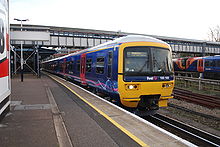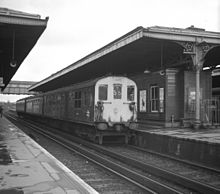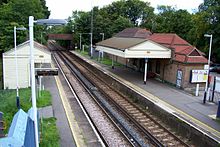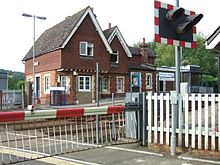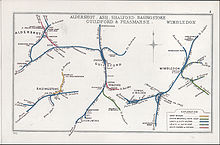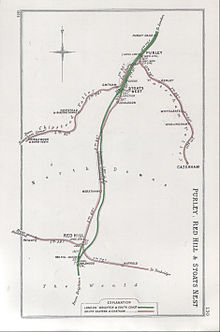- North Downs Line
-
North Downs Line 
North Downs LineOverview Type Suburban rail, Heavy rail System National Rail Status Operational Locale Berkshire, Hampshire, Surrey Termini Reading
RedhillOperation Opened 1849 Owner Network Rail Operator(s) First Great Western Depot(s) Reading TMD Rolling stock Class 165, Class 166 Technical Track gauge 1,435 mm (4 ft 8 1⁄2 in) Standard gauge Electrification Partially electrified Operating speed 70 mph (110 km/h) (maximum) The North Downs Line is the name of the passenger train service connecting Reading, on the Great Western Main Line, to Gatwick Airport, on the Brighton Main Line. It is also the name used to refer to the line over which these services run between Reading and Redhill[1].
Contents
- 1 The route
- 2 History of the line's construction
- 3 Technical information
- 4 Current passenger services and rolling stock
- 5 Passenger services and rolling stock before privatisation
- 6 Freight services and rolling stock
- 7 Electrification proposals
- 8 Lineside features
- 9 Network Rail routes
- 10 Typical off-peak journey times from Reading
- 11 See also
- 12 References
- 13 Further reading
The route
Despite its name the line does not run along the top of the North Downs, but loosely shadows the main chalk ridge of the North Downs between Redhill and Ash at a lower level. Between Reigate and Gomshall the line runs along the foot of the North Downs escarpment in the Vale of Holmesdale. At Guildford it runs through the gap in the Downs carved by the river Wey, with a short tunnel just south of Guildford station, and further west between Guildford and Ash the line runs to the north of the Hog's Back. It then follows the Blackwater valley as far as Sandhurst, before continuing to Reading.
History of the line's construction
The line was authorised by Acts of Parliament in 1846 and 1847 and most of it was constructed by the Reading, Guildford and Reigate Railway Company (RG&RRC), opening in 1849. (A central section of the line near Guildford was built by a predecessor of the LSWR.) The stated objective of the company was to
"secure through traffic passing between the West, North and Midlands and the Channel Ports avoiding the congestion of London and thus saving time, distance and expense."[2]
Although the company had some independent shareholders, it was closely associated with the South Eastern Railway (SER). The original intention was for the SER to build part of the line itself, but this proposal was rejected by Parliament. The independence of the company was only a formality to satisfy Parliament. The two companies had some common directors; a SER engineer controlled the construction of the line. As intended at outset, the line was leased to the SER in 1850, and the two companies finally merged in 1852. The company's relationship with the GWR is described as "enigmatic". The GWR initially offered the company the use of its facilities at Reading station but terms could not be agreed and a separate station was built.[3]
The SER operated the line from its opening, and ran passenger services on it from Reading to London Charing Cross via Redhill. Even today, the distances along the line are measured from the terminus of the former SER.
Technical information
The line is two track throughout, except for a short single track section on the approach to Reading. Reversible working is provided on the down line[clarification needed] between Guildford and Shalford. The entire line is designated W6 gauge and overnight engineering possessions of up to 4.5 hours are available.[1]
- Reading to Wokingham is electrified (3rd rail, 750 V DC) and signalled under the TCB (Track circuit block) system from Wokingham Signal Box. Signalling headways are 3 minutes for fast services and 3.5 minutes for stopping services. The line speed is 70 mph (110 km/h), except for two 30 mph (48 km/h) restrictions (on the approach to Reading and through Wokingham station).
- Wokingham to North Camp is also under the control of Wokingham Signal Box, however long distances between signals increase headways to 6 minutes and 11 minutes for fast and stopping services respectively (the longest headways on the line). This section is not electrified and the line speed is 70 mph.
- North Camp to Shalford Junction is controlled from Guildford (TCB). Signalling headways are 2 minutes with an additional 1 minute added for stopping services. This section is electrified (3rd rail, 750 V DC) from Aldershot South Junction. The line speed is 70 mph, except for a 40 mph (64 km/h) restriction at Ash Junction (between Ash and Wanborough) where the line curves sharply, and a 30 mph restriction on the approaches to Guildford station.
- Shalford Junction to Reigate The route leaves the Portsmouth Direct Line at Shalford Junction and there is a 20 mph restriction. From here to Reigate the line is not electrified. It is controlled by Guildford from Shalford Junction to Gomshall and by Reigate Signal Box (TCB) from Gomshall to Redhill. Signalling headways are 5 minutes for fast trains and 7 minutes for stopping services. The line speed varies from 30 mph (on the approach to Shalford junction) to 70 mph.
- Redhill to Reigate is electrified (3rd rail, 750 V DC). The approach to Redhill is controlled by Three Bridges Signalling Centre and has a 30 mph speed restriction.
The major capacity constraints are the platform capacities of Reading, Redhill and Gatwick Airport stations.[4] [5][6]
At Reading, North Downs Line services normally terminate at platforms 4a and 4b on the south side of the station, although access to other platforms is possible via a junction with the Great Western Main Line (see map, right). Trains could formerly access the north side of Reading station via an underpass, although this has been disused for some time. The access to platforms 4a and 4b is via a short single track section, which severely limits capacity. As part of the 2012 Reading resignalling scheme, an additional platform will be provided for North Downs Line services. The underpass may also be reinstated.[7]
Network SouthEast originally planned to electrify the whole route, with a completion date of 1993 being published, but these plans were dropped.[8]
Current passenger services and rolling stock
The main services on the line are provided by First Great Western using Class 165 and Class 166 Network Turbo diesel multiple units. Hourly semi-fast services run from Reading to Gatwick Airport and there is an hourly stopping service between Reading and Redhill. At Redhill the Gatwick Airport services reverse to head south along the Brighton Main Line.[4] Before 1994, the stopping services continued to Tonbridge, however the line between Redhill and Tonbridge was electrified in 1993 to provide an additional diversionary route for Eurostar trains to continental Europe. Services on this line now run to London Bridge and are operated by Southern.[9]
Additional services on the North Downs Line are provided by South West Trains between Reading and Wokingham (trains to/from London Waterloo) and between Ash and Guildford (trains to/from Alton or Ascot). Southern operate weekday peak hour services between Reigate and Redhill and onwards to London.[9]
Passenger services and rolling stock before privatisation
Steam traction was replaced by 3R (Class 206) DEMUs on 4 January 1965. The new trains consisted of two 6S (class 201) coaches from the Hastings Line coupled to adapted 2EPB driving trailer units. As a result of the visible difference in width between the narrow Hastings Line stock and the standard width Hampshire trailer, the units were nicknamed Tadpoles.[10] Additional peak time services were hauled by class 33 diesel locomotives until May 1977.[2]
The express service from Reading to Gatwick Airport was launched on 12 May 1980 using three-car class 119 DMMUs, based on the Western region. The trains were especially modified for this service to create extra luggage space: the buffet counter in the centre coach was removed. Class 101 three-car units were later used on the route as well.[11]
All of the stations between Shalford and Betchworth inclusive, were recommended for closure in the Beeching Report of 1962.[12] The report recommended that the whole of the North Downs Line should be developed as a trunk route.[13]Freight services and rolling stock
As of 2007[update] there are no scheduled freight services which use the line.[4] The Travelling Post Office train from Dover to Manchester via Tonbridge, Redhill, Guildford and Reading was routed along the line from May 1988 until 2004.[2] The Network Rail 2008 Strategic Business Plan recommended that an enhancement project for the line should be pursued to enable freight traffic from the Channel Tunnel to use the line.[14]
Electrification proposals
Electrification had been shelved prior to World War II as it was felt that little traffic would be generated. Unelectrified routes of the North Downs Line included Wokingham railway station to Ash railway station (Aldershot South Junction) and Shalford Junction to Reigate. In August 1981, Modern Railways magazine studied an electrification strategy for the then Southern Region of British Railways. The article saw potential on the route with the area having developed rapidly, and also with the prospect of Channel Tunnel traffic; cross-country passenger and freight workings might also be diverted along the route. Subsequently some of the routes considered were indeed electrified; other routes mentioned included South Croydon-Oxted-East Grinstead* (1987), Bournemouth-Weymouth (1988), Hilsea/Farlington Junction-St Denys/Eastleigh (1990) and Redhill-Tonbridge (at the time the furthest extent of North Downs Line services, in 1994).
According to internet sources[clarification needed], electrification of these sections of the North Downs Line was again discussed as part of the Blackwater Valley Rail Survey, in 1991. Motive power from the outset would have been the BR Mark 1-based electric stock classes, but the idea was scrapped when the conventional diesel multiple units on the region began to be replaced by the current Class 165/166 'Turbos'.
*Hurst Green/Tunbridge Wells to Eridge and Uckfield was also mentioned in the same scheme, but remains unelectrified today. The Tunbridge Wells-Eridge portion closed to BR passenger traffic in 1985.
Lineside features
 External videos
External videos
Steam-hauled excursion passing the yew bush Jesse's Seat, near Chilworth, 2 March 2007. On the south side of the line between Chilworth and Gomshall a yew hedge known as Jesse's Seat has been cut into the shape of a pheasant. It is a memorial to a guard who was killed in an accident at this spot in about 1910.[15] [16]
Network Rail routes
The service uses all or part of the following Network Rail routes:[17]
- SW 210 from Reading
- SW 265 from Wokingham
- SW 110 from Guildford
- SW 300 from Shalford Junction
- SO 560 from Gomshall to Redhill
Typical off-peak journey times from Reading
Based on the December 2006 - May 2007 timetable. Stations in italics are served in peak hours only.
Destination Semi-fast services
(minutes)Stopping services
(minutes)Frequency
(trains per hour)Change for Winnersh 7 Wokingham 9 9 2 London Waterloo via Bracknell and Staines Crowthorne 14 1 Sandhurst 18 1 Blackwater 14 21 2 Farnborough North 26 1 North Camp 23 30 2 Ash 34 1 Aldershot, Farnham, Alton and Ascot Wanborough 38 Guildford 34 45 2 London Waterloo and Portsmouth Harbour Shalford 49 1 Chilworth 53 0.5 Gomshall 59 0.5 Dorking West 62 0.5 Dorking (Deepdene) 52 64 2 London Waterloo, London Victoria and Horsham from Dorking Station Betchworth 69 0.5 Reigate 60 74 2 Redhill 64 81 2 London Victoria, London Bridge and Tonbridge Gatwick Airport 76 1 Eastbourne, Brighton and Littlehampton Between Guildford and Redhill the off-peak stopping service pattern alternates every hour, giving Shalford an hourly service and Chilworth, Gomshall, Dorking West and Betchworth one train every two hours.
Hour 1 Guildford Shalford Chilworth Gomshall Dorking (Deepdene) Reigate Redhill Hour 2 Guildford Shalford Dorking West Dorking (Deepdene) Betchworth Reigate Redhill During peak hours the stopping service between Guildford and Redhill calls at all stations.
See also
- Great Western Main Line
- Reading to Waterloo Line
- Alton Line
- Portsmouth Direct Line
- Mole Valley Line
- Brighton Main Line
- Redhill to Tonbridge Line
References
- ^ a b "Business Plan 2006 - Route 3: South West Main Line" (PDF). http://www.networkrail.co.uk/documents/3102_Route%203%20South%20West%20Main%20Line.pdf. Retrieved 2010-11-17.
- ^ a b c Jackson, AA (1988). Dorking's Railways. Dorking: Dorking Local History Group. ISBN 1870912012.
- ^ Minutes of the Board of Directors of the RG&RRC, ed. by Edwin Course, 1987 ISBN 0 902978 08
- ^ a b c Network Rail: Reading to Gatwick Airport - Congested Infrastructure Capacity Analysis (2007) http://www.networkrail.co.uk/documents/4091_Reading%20to%20Gatwick%20Capacty%20Analysis.pdf
- ^ "36470 RUS SWML 80pp.indd" (PDF). http://www.railwaysarchive.co.uk/documents/NR_RUSSW2005.pdf. Retrieved 2010-11-17.
- ^ "Network Rail Route Plan 2004 (Page 42) (9.4mb PDF)" (PDF). http://www.railwaysarchive.co.uk/documents/NR_RoutePlan2004.pdf. Retrieved 2010-11-17.
- ^ "Microsoft Word - Inf Note - Network Rail Business Plan.doc" (PDF). http://www.southwest-ra.gov.uk/media/SWRA/RSPTG/14th%20May%202007/Inf_Note_-_Network_Rail_Business_Plan.pdf. Retrieved 2010-11-17.
- ^ Brown, David and Jackson, Alan A. (1990): Network SouthEast Handbook, page 20. Capital Transport Publishing, Harrow Weald. ISBN 1-85414-129-5
- ^ a b [1][dead link]
- ^ "3R (Class 206) "Tadpole" DEMUs". Semgonline.com. http://www.semgonline.com/gallery/class206.html. Retrieved 2010-11-17.
- ^ Brown, David; Jackson, Alan A. (November 1990). Network Southeast Handbook. Harrow Weald: Capital Transport Publishing. ISBN 978-1854141293.
- ^ Beeching R (1963) The Reshaping of British Railways
- ^ Beeching R (1965) Development of the major railway trunk routes
- ^ "Strategic Business Plan Update" (PDF). http://www.networkrail.co.uk/browse%20documents/StrategicBusinessPlan/Update/Strategic%20Business%20Plan%20April%20update.pdf. Retrieved 2010-11-17.
- ^ Alan C. Edwards (28 Feb 2004). "The Railway at Chilworth, Surrey". Rough notes of the talk at Chilworth Village Hall. http://website.lineone.net/~alan.c.edwards/chilworthtalk040228.html. Retrieved 23 March 2010.
- ^ Mitchell, Vic; Smith, Keith (1989). Guildford to Redhill. Country Rail Routes. Midhurst: Middleton Press.
- ^ Network Rail: Rules of the Plan (Southern) (2007 Timetable) http://www.networkrail.co.uk/browse%20documents/Rules%20Of%20The%20Route/Outrotp7/so07p.pdf
Further reading
- Butt, R.V.J. (1995). The Directory of Railway Stations. Patrick Stephens Ltd. ISBN 1-85260-508-1.
Railway lines in the South East Primary 
Secondary Bexleyheath Line · Brighton Main Line · Caterham Line · Chatham Main Line · Chiltern Main Line · Dartford Loop Line · Epsom Downs Branch · London to Aylesbury Line · North Kent Line · Oxted Line · Shepperton Branch Line · South Eastern Main Line · South Western Main Line · Sutton & Mole Valley Lines · Tattenham Corner Line · Thameslink · Waterloo to Reading LineLocal Alton Line · Arun Valley Line · Ascot to Guildford line · Ashford to Ramsgate (via Canterbury West) line · Cherwell Valley Line · Cotswold Line · East Coastway Line · Eastleigh to Fareham line · Eastleigh to Romsey Line · Hampton Court Branch Line · Hastings Line · Henley Branch Line · Hundred of Hoo Railway · Island Line, Isle of Wight · Kent Coast Line · Lymington Branch Line · Maidstone East Line · Marlow Branch Line · Marshlink Line · Marston Vale Line · Medway Valley Line · New Guildford Line · North Downs Line · Oxford to Bicester Line · Oxfordshire Ironstone Railway · Portsmouth Direct Line · Princes Risborough to Aylesbury Line · Reading to Basingstoke Line · Reading to Taunton Line · Redhill to Tonbridge Line · Sheerness Line · Slough to Windsor & Eton Line · Staines to Weybridge Line · Staines to Windsor Line · Wessex Main Line · West Coastway Line · West of England Main LineCategories:- Rail transport in Berkshire
- Rail transport in Hampshire
- Railway lines opened in 1849
- Railway lines in South East England
Wikimedia Foundation. 2010.

